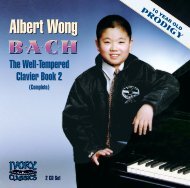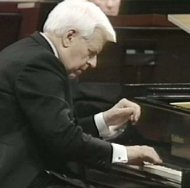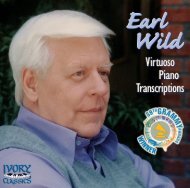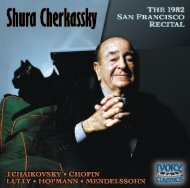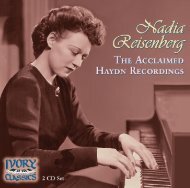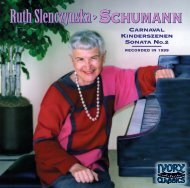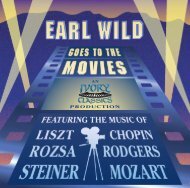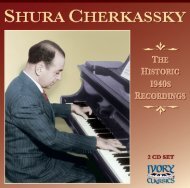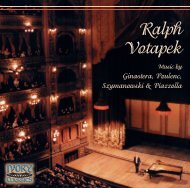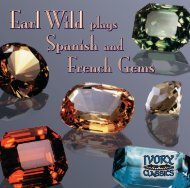RACHMANINOFF - Ivory Classics
RACHMANINOFF - Ivory Classics
RACHMANINOFF - Ivory Classics
You also want an ePaper? Increase the reach of your titles
YUMPU automatically turns print PDFs into web optimized ePapers that Google loves.
<strong>RACHMANINOFF</strong><br />
Earl Wild<br />
Chopin Variations, Op. 22<br />
Corelli Variations, Op. 42<br />
Preludes, Opp. 23 & 32<br />
Sonata No. 2, Op. 36<br />
Piano Transcriptions<br />
2-CD Set
<strong>RACHMANINOFF</strong><br />
Earl Wild<br />
Disc I<br />
1<br />
2<br />
3<br />
4<br />
5<br />
Variations on a Theme of Chopin Op. 22..........................26:38<br />
Variations on a Theme of Corelli Op. 42...........................17:40<br />
Rimsky-Korsakov/Rachmaninoff<br />
The Flight of the Bumble-Bee............................................1:31<br />
Mendelssohn/Rachmaninoff<br />
Scherzo from ‘A Midsummer Night’s Dream’............4:38<br />
Kreisler/Rachmaninoff<br />
Liebesleid......................................................................................5:21<br />
To ta l Ti m e: 55:14<br />
- 2 -
Disc II<br />
1<br />
2<br />
3<br />
4<br />
5<br />
6<br />
7<br />
8<br />
9<br />
10<br />
11<br />
12<br />
13<br />
Sonata No. 2<br />
in B-flat minor, Op. 36<br />
Allegro agitato................... 7:39<br />
Non allegro......................... 6:18<br />
Allegro molto..................... 5:55<br />
Ten Preludes, Op. 23<br />
No. 1 in F-sharp minor.... 3:24<br />
No. 2 in B-flat Major........ 3:37<br />
No. 3 in D minor.............. 2:40<br />
No. 4 in D Major............... 4:13<br />
No. 5 in G minor.............. 3:35<br />
No. 6 in E-flat Major........ 2:35<br />
No. 7 in C minor............... 2:22<br />
No. 8 in A-flat Major....... 2:57<br />
No. 9 in E-flat minor........ 1:58<br />
No. 10 in G-flat Major..... 3:41<br />
14<br />
15<br />
16<br />
17<br />
18<br />
19<br />
20<br />
21<br />
22<br />
Nine Preludes, Op. 32<br />
No. 1 in C Major............... 1:13<br />
No. 2 in D-flat Major....... 2:56<br />
No. 3 in E Major............... 2:19<br />
No. 4 in E minor............... 5:08<br />
No. 5 in G Major............... 2:49<br />
No. 6 in F minor............... 1:28<br />
No. 7 in F Major............... 2:16<br />
No. 8 in A minor............... 1:41<br />
No. 10 in B minor............. 2:40<br />
To ta l Ti m e - 73:56<br />
- 3 -
<strong>RACHMANINOFF</strong><br />
Sergei Rachmaninoff was rare among the great composers of history in that he<br />
was also a famed conductor and pianist, in equal measure. On these discs, of course,<br />
our attention is on his work as a composer and transcriber, but we must not forget<br />
the musical scope of this genius. He was renowned as a conductor and pianist,<br />
no less than as a composer, enjoying an international reputation and immense<br />
popularity for his work in all three arenas. He was the last great proponent of late<br />
Russian Romanticism.<br />
Sergei Vasilyevich Rachmaninoff was the second son born into an aristocratic<br />
Russian family in 1873, in the town of Oneg, near St. Petersburg. His father was<br />
Vasily Arkadyevich, an army man, and his mother was Lyubof Petrovna Butakova.<br />
Both of them were pianists. Vasily proved ill-equipped to manage his wife’s five<br />
estates, and was inclined to fecklessness and womanizing. He wanted Sergei to<br />
follow family tradition and enter the army, but the family fell on hard times and had<br />
to auction off their last estate, in Oneg–where they were living. Sergei and two of his<br />
siblings later became ill with diphtheria but recovered; their sister died. Their father<br />
subsequently left the family, and the children fell to the care of Lyubof alone. Sergei’s<br />
later bouts with depression and a sense of inadequacy were brought about, in part,<br />
by these tumultuous times in his family life.<br />
In his early years at the St. Petersburg Conservatory, Sergei impressed his teachers<br />
by his musical acumen, and he played recitals for musical and social celebrities, but<br />
in all other subjects he failed, being prone to laziness and mischief.<br />
At the conservatory he studied piano with Alexander Siloti, his cousin, who<br />
had studied with Franz Liszt in Weimar from 1883 to 1886. Siloti toured Europe<br />
- 4 -
and in 1898 he toured the United States. From 1901 to 1903 he led the Moscow<br />
Philharmonic, and in 1901 he conducted the world premiere of Rachmaninoff’s<br />
Second Piano Concerto. He taught at the Juilliard School in New York from 1925 to<br />
1942 and was a major proponent of the art of transcription.<br />
In the autumn of 1889, Sergei moved to the Moscow home of his uncle Alexander<br />
and his aunt Varvara, after Siloti had recommended Sergei to his own former teacher,<br />
the autocratic Nikolai Zverev (1832-1893), a prominent piano pedagogue, who<br />
accepted into his Moscow home only male students on audition. At age twelve,<br />
Sergei moved into Zverev’s large apartment and stayed for four years, subjected to a<br />
rigorous regimen of piano practice, and obliged to attend opera and chamber music<br />
concerts. Alexander Scriabin was another of his more famous pupils.<br />
During his time at the Moscow Conservatory, Sergei studied composition with the<br />
pianist, conductor, and composer Anton Arensky, and with Alexander Taneyev, a fine<br />
composer but a bureaucrat by day. At age eighteen Sergei graduated from the conservatory<br />
as a pianist, and at nineteen (in 1892) he graduated as a composer, successfully submitting<br />
his one-act opera Aleko, which he composed in only fifteen days.<br />
During the summer of 1890, Sergei’s aunt and uncle took him for his first visit<br />
to the couple’s beautiful and idyllic country estate named Ivanovka, which was over<br />
two hundred miles south-east of Moscow. The seventeen-year old Sergei grew to love<br />
Ivanovka, which would provide him with twenty-seven years of creative refreshment<br />
and musical inspiration. After 1902, the year he married his first cousin, Natalya Satina,<br />
with whom he had two daughters, he spent most of his summers at Ivanovka composing.<br />
Many of his works were composed there, including the early Prelude in C-sharp minor<br />
for piano, which would prove to be his most popular work. During the Russian<br />
Revolution, in 1917, Ivanovka was burned to the ground by the revolutionaries.<br />
Rachmaninoff completed his First Symphony, in D minor, in 1895, when he<br />
was twenty-two years old. In 1897 it had a disastrous premiere under Alexander<br />
- 5 -
Glazunov, which plunged the composer into a three-year period of despair, during<br />
which he composed nothing of significance. But he emerged from his depression<br />
to begin a career as a conductor, directing a number of operas in quick succession,<br />
and to compose his Second Piano Concerto, probably the most popular of all piano<br />
concertos ever written.<br />
In 1909 Rachmaninoff made his first trip to the United States, during which<br />
he played the first performance of his Third Piano Concerto with the New York<br />
Symphony Orchestra and conducted both the Boston Orchestra and the New York<br />
Philharmonic. He was offered the post of conductor with the Boston Symphony, but<br />
declined. He returned to North America once in every season thereafter, going on<br />
exhausting tours as a conductor and pianist.<br />
The Russian Revolution divided Rachmaninoff’s compositional career into two<br />
parts, each of twenty-six years duration. During the first, from 1891 until 1917, he<br />
composed thirty-nine works with opus numbers. But during the second period,<br />
from 1917 until his death in 1943, when he lived in exile, he composed only six<br />
more. Two principal reasons may be given for his having composed so little after the<br />
revolution. First of all, he was not happy with life in exile–mostly in Switzerland and<br />
the United States–and it is known that he did his best composing when he was free of<br />
tension and turmoil. And secondly, he was forced by circumstances to shift his focus<br />
from composing to performance, just to support his family. His career as a concert<br />
pianist, therefore, did not begin until after the revolution, and after leaving Russia<br />
he never returned. Nevertheless, Rachmaninoff composed a total of six operas, a<br />
number of choral works and vocal pieces, in addition to his symphonies, piano<br />
concertos, symphonic poems and chamber works, along with his numerous works<br />
for solo piano, including his piano transcriptions and arrangements (for example,<br />
J.S. Smith’s The Star-Spangled Banner of 1918).<br />
In November of 1918, after sojourns in Stockholm and Copenhagen,<br />
- 6 -
Rachmaninoff and his family arrived in New York, whereupon he gave forty concerts<br />
in four months. In New York his family attempted to recreate the life-style of Ivanovka<br />
and follow Russian aristocratic customs. It was there that he worked on his Fourth<br />
Piano Concerto, giving its first performance in Philadelphia in 1927.<br />
Between 1919 and 1942, Rachmaninoff made a number of recordings (including<br />
piano rolls), totaling some fifteen hours and thirteen compact discs. His earliest<br />
recordings, in March 1919, when he was nearly forty-six, were made using the<br />
piano roll technology of Ampico (the American Piano Company). He continued<br />
recording for Ampico for another ten years, until 1929, but in 1919 he also made<br />
some recordings for Edison, using hill-and-dale discs, on an upright piano. In 1920<br />
he inaugurated his famous series of gramophone recordings for the Victor Talking<br />
Machine Company (later RCA Victor), using only Steinway concert grand pianos. His<br />
last recording session for Victor was in Hollywood in 1942, the year before his death.<br />
The fidelity of the gramophone recordings was poor in those early years, of course,<br />
but the piano rolls captured his performances exactly as he had played them. None of<br />
his live recordings survive except for a duet that he played with his wife at a party.<br />
As for the process of composition, Rachmaninoff said, “I hear the music in my<br />
head. When the music stops, I write it down.” His inspiration was often literary or<br />
pictorial, but he was profoundly influenced by the chants of the Russian Orthodox<br />
Church, by church bells, and by the music of the Gypsies. He found it difficult, if not<br />
impossible, to compose when his emotional life was in disarray.<br />
Although it has been suggested that several of his works betray a kind of<br />
“personal neo-classicism” (Francis Crociata), Rachmaninoff was influenced early on<br />
by Tschaikovsky, finding his own inimitable style only later. He believed that every<br />
worthy piece of music has a single “culminating point,” whether in the middle or at<br />
the end, which the performer must approach with the greatest care and calculation.<br />
Above all, his music exudes characteristic Russian sadness and melancholy, much of<br />
- 7 -
it being dark-hued and nostalgic.<br />
Though he was a gifted pianist, Rachmaninoff never intended to perform as one.<br />
But being forced out of Russia by the revolution, he had to re-invent himself as a concert<br />
performer–and spend lots of time learning a huge body of new repertoire–so that he<br />
could support his family. By the mid 1920s he was an international piano celebrity.<br />
Rachmaninoff had very large hands that were capable of reaching a twelfth at<br />
the keyboard (Mr. Wild can stretch to an eleventh), and had a formidable technique.<br />
He also had an amazing musical memory and phenomenal sight-reading skills. He<br />
approached piano repertoire as a composer, and said: “You must take the work apart,<br />
peer into every corner, before you can assemble the whole.” Because of his close<br />
adherence to the printed score, his quest for the “culminating point” of a piece, and<br />
his aversion to sentimentality, he became known as the “Puritan Pianist.”<br />
A true romantic, however, Rachmaninoff transcribed for the piano an imposing<br />
body of works originally intended for other instruments or voice–and idiomatically so.<br />
His piano transcriptions and arrangements are worthy of other renowned transcribers,<br />
including Franz Liszt, Ferruccio Busoni, and Leopold Godowsky. Believing that<br />
transcriptions were a normal part of music-making, he recorded many of them. Besides<br />
the three transcriptions that appear on these recordings, he also transcribed J.S. Bach’s<br />
Partita in E and the minuet from Georges Bizet’s L’Arlésienne Suite. (During the summer<br />
of 1981, Mr. Wild transcribed fourteen of Rachmaninoff’s songs for piano.)<br />
Five days before his seventieth birthday, Rachmaninoff died at his home in<br />
Beverly Hills, on March 28, 1943, suffering from lumbago, arthritis, extreme fatigue,<br />
and cancer. He was buried at the Kensico Cemetery, near Valhalla, in Westchester<br />
County, New York.<br />
- 8 -
Va r i at i o n s o n a Th e m e o f Ch o p i n<br />
After the disappointing premiere and scathing reviews of his First Symphony,<br />
Rachmaninoff was unable to compose for some three years, but his self-confidence<br />
was restored as a result of therapy with the hypnotist Dr. Nikolai Dahl. Moreover in<br />
1901, Rachmaninoff gave a successful premiere of his famous Second Piano Concerto.<br />
The success of the therapy and the premier, together with his marriage, led to a<br />
productive period in Rachmaninoff’s life. In the years 1902-3 he composed his Ten<br />
Preludes, Op. 23, along with the Variations on a theme of Chopin, Op. 22, his first large<br />
piano work, giving its premiere on February 10, 1903 at a concert for the Ladies’<br />
Charity Prison Committee in Moscow.<br />
The theme of the Variations is a slight abridgment of the theme from Frédéric<br />
Chopin’s Prelude, Op. 28, No. 20, though Rachmaninoff does not repeat the second<br />
half. It is interesting that Rachmaninoff is not known to have performed the Chopin<br />
work publicly.<br />
These are the tempo indications and keys for the individual variations: The<br />
Theme (Largo), in C minor; Var. 1: Moderato, C minor; Var. 2: Allegro, C minor; Var.<br />
3: L’istesso tempo, C minor; Var. 4: L’istesso tempo, C minor; Var. 5: Meno mosso,<br />
C minor; Var. 6: Meno mosso, C minor; Var. 7: Allegro, C minor; Var. 8: L’istesso<br />
tempo, C minor; Var. 9: L’istesso tempo, C minor; Var. 10: Più vivo, C minor; Var.<br />
11: Lento, C minor; Var. 12: Moderato, C minor; Var. 13: Largo, C minor; Var. 14:<br />
Moderato, C minor; Var. 15: Allegro scherzando, F minor; Var. 16: Lento, F minor;<br />
Var. 17: Grave, E-flat minor; Var. 18: Più mosso, B-flat minor; Var. 19: Allegro vivace,<br />
A major; Var. 20: Presto, C-sharp minor; Var. 21: Andante; Più vivo, D-flat major;<br />
Var. 22: Maestoso; Tempo primo; Meno mosso, C major.<br />
The Chopin Variations are dedicated to Theodore Leschetizky, the great Polish<br />
pianist and teacher whose pupils included Ignace Paderewski and Artur Schnabel.<br />
- 9 -
Apparently Rachmaninoff was not completely satisfied with the Variations, as he<br />
authorized pianists to omit variations 7, 10 and 12, along with the coda. On this<br />
disc, however, Mr. Wild wisely plays the work in its entirety.<br />
The Variations are full of tuneful melodies, Rachmaninoff’s hallmark melancholy,<br />
and his chromatic harmonies, and they demonstrate a mastery of large-scale forms.<br />
It has been noted by Robert Matthew-Walker that the twenty-two variations are<br />
grouped irregularly, giving the work the outline of a four-movement sonata. Many of<br />
the variations are longer than their predecessors, giving the listener the sense of “a<br />
cumulative journey of wholly organic growth.”<br />
Va r i at i o n s o n a Th e m e o f Corelli<br />
Rachmaninoff composed very little during the 1920s, apart from his Fourth<br />
Piano Concerto, which received an indifferent reception at its premiere in 1927. The<br />
Variations on a Theme of Corelli, Op. 42, composed in 1931, is Rachmaninoff’s last<br />
original work for solo piano, and the only solo-piano work composed between 1917<br />
and his death in 1943. He produced the Variations concurrently with his revision of<br />
the Second Sonata.<br />
Despite their title, the twenty brief variations (plus an Intermezzo and a Coda) are<br />
based not on a theme of Arcangelo Corelli (1653-1713), but on the popular melody<br />
La Folia (Madness), which Corelli had used for his Sonata, Op. 5, No. 12, for violin.<br />
It is actually an old Iberian folkdance tune, and is said to have been introduced to<br />
Rachmaninoff by Fritz Kreisler, to whom the Variations are dedicated. La Folia first<br />
appeared in the sixteenth century and has been used by over 150 composers over<br />
the course of ensuing centuries. Rachmaninoff played the premiere of the Corelli<br />
Variations in Montreal on October 12, 1931.<br />
Tempo indications and keys of the individual variations are: Theme (Andante),<br />
- 10 -
D minor; Var. 1: Poco più mosso, D minor; Var. 2: L’istesso tempo, D minor; Var. 3:<br />
Tempo di Minuetto, D minor; Var. 4: Andante, D minor; Var. 5: Allegro ma non tanto,<br />
D minor; Var. 6: L’istesso tempo, D minor; Var. 7: Vivace, D minor; Var. 8: Adagio<br />
misterioso, D minor; Var. 9: Un poco piu mosso, D minor; Var. 10: Allegro scherzando,<br />
D minor; Var. 11: Allegro vivace, D minor; Var. 12: L’istesso tempo, D minor; Var. 13:<br />
Agitato, D minor; Intermezzo; Var. 14: Andante come prima, D-flat major; Var. 15:<br />
L’istesso tempo, D flat major; Var. 16: Allegro vivace, D minor; Var. 17: Meno mosso, D<br />
minor; Var. 18: Allegro con brio, D minor; Var. 19: Più mosso; Agitato, D minor; Var.<br />
20: Più mosso, D minor; Coda (Andante), D minor. Note that the entire work is in D<br />
minor (the key of Corelli’s violin sonata), except for variations 14 and 15.<br />
On January 15 of 1931, Rachmaninoff’s name appeared in The New York Times<br />
as signatory to a letter that was critical of the current regime in Russia. He was<br />
despondent over the matter when he wrote the Corelli Variations, beginning in<br />
May, when he was in Clairefontaine, France. Two months later a Moscow review<br />
of a performance of his work The Bells referred to him as a “violent enemy of Soviet<br />
Russia.” As a result there ensued a Russian boycott of his music.<br />
Rachmaninoff sent a copy of the Corelli Variations to fellow Russian composer<br />
and pianist Nikolai Medtner (1880-1951) who was living in England, writing<br />
flippantly that he was “guided by the coughing of the audience” as to how many of<br />
the variations he played: “Whenever the coughing increased I would skip the next<br />
variation...I hope that you will play them all and won’t cough.”<br />
Despite his comment, the Variations are among Rachmaninoff’s finest work, though<br />
they are fiendishly difficult and gnarly in their complexity. They have a large-scale<br />
structure and a clarity of line lacking in some of his earlier works, and he handles the<br />
sad theme with greater rhythmic and harmonic freedom than elsewhere. Noël Goodwin<br />
points out that “it is impossible not to see in these Corelli Variations a precursor of the<br />
ever-popular Rhapsody on a Theme of Paganini, for piano and orchestra.”<br />
- 11 -
Earl Wild’s astonishing technique and stunning musicianship make light work<br />
of these masterful compositions. Rachmaninoff allows performers the option to<br />
eliminate variations 11, 12, and 19, but Mr. Wild plays them all.<br />
Ri m s k y-Ko r s a k o f f/Ra c h m a n i n o f f: Fl i g h t o f t h e Bumblebee<br />
Nikolai Rimsky-Korsakoff (1844-1908), the Russian composer and conductor,<br />
had a penchant for his country’s folk tales and legends and he was deeply influenced<br />
by his experience of nature during his round-the-world trip on a schooner. He was<br />
also an extraordinary orchestrator, perhaps as a result of his having synesthesia. In<br />
fact, he wrote a book called The Principles of Orchestration (1908). His most renowned<br />
pupil was Igor Stravinsky.<br />
Flight of the Bumblebee is an orchestral interlude from Rimsky-Korsakoff’s opera<br />
The Tale of Tsar Saltan (1899-1900), one of his fifteen operas. In the story, the Swan-<br />
Bird tells the prince, the son of the Tsar, how to turn himself into a bumblebee so<br />
that he can fly off to sting his two villainous aunts and visit his father. The Swan-Bird<br />
sings during the first part of the Flight, but the line can be excised without doing<br />
violence to the work.<br />
Rachmaninoff transcribed the piece for piano probably in 1929 and recorded it on<br />
his last Ampico roll in the same year. But besides the piano, Bumblebee has been played<br />
on everything from the accordion and electric guitar to the xylophone and pipe organ.<br />
Me n d e l s s o h n/Ra c h m a n i n o f f:<br />
Scherzo, f r o m A Mi d s u m m e r Ni g h t’s Dr e a m<br />
The orchestral Scherzo, from Mendelssohn’s Opus 61, No. 1, comes from the<br />
incidental music he composed for A Midsummer Night’s Dream–the play by William<br />
- 12 -
Shakespeare. It is one of Rachmaninoff’s “most vivid paraphrases” (Max Harrison).<br />
Mendelssohn composed the work on commission from King Friedrich Wilhelm<br />
IV of Prussia and completed it in 1842. One of its other movements is the famed<br />
Wedding March used for generations to hurry brides and grooms from churches. The<br />
Scherzo, transcribed by Rachmaninoff in 1933, is extremely difficult to play on the<br />
piano because of the density of the writing; there is so much going on at once.<br />
Mr. Wild’s performance has a wide range of articulation and touch, from elfin<br />
lightness to dry staccato and muscularity, helping to reveal the shape of the piece,<br />
providing a clear sense of Mendelssohn’s organization of the work, and showing<br />
the relationship of various inner parts...characteristics often lacking in performances<br />
where sheer velocity is the only goal. Far from a mere digital exercise, Mr. Wild’s<br />
rendition is full of sparking wit and brilliance. The work has also been played by<br />
flute and string quartets.<br />
Kreisler/Ra c h m a n i n o f f: Liebesleid<br />
Fritz Kreisler (1875-1962) was born in Vienna and was one of the most<br />
distinguished violinists of all time, at least since Paganini. He wrote about sixty<br />
original works along with a number of transcriptions and arrangements of existing<br />
works, by such composers as Tartini, Corelli, Paganini, Paderewski, Schumann, and<br />
Granados, including some which were later discovered to have been original with<br />
him–and therefore not transcriptions at all. Kreisler’s Liebesleid (love song) is one of<br />
his original works and was composed for violin and piano.<br />
Kreisler and Rachmaninoff were great friends and together they recorded sonatas<br />
by Beethoven, Schubert, and Grieg. Rachmaninoff transcribed Liebesleid in1921 and<br />
recorded it for Victor in the same year.<br />
- 13 -
Pi a n o So n ata No. 2 in B-flat m i n o r<br />
Rachmaninoff composed two sonatas for the piano, and both are considered<br />
masterpieces. The Second Sonata, composed in 1913, is not as large as the first,<br />
and is dedicated to Matvey Pressmann, a long-time friend and fellow student of<br />
Rachmaninoff’s while at the home of Nikolai Zverev. In the summer of 1931<br />
Rachmaninoff revised the work, and it is the revision that Mr. Wild plays on this<br />
recording. Besides the revised sonata, Rachmaninoff composed his Corelli Variations<br />
during that summer, and performed both works in Montreal later in the year.<br />
The revised version has three distinct sections: Allegro agitato, Meno mosso<br />
[attacca], and Non allegro. The original version was longer and considerably more<br />
complex, having the following sections: Allegro agitato – Meno mosso; Non allegro<br />
– Lento – Più mosso; Allegro molto – Poco meno mosso – Presto. Rachmaninoff said<br />
of the original version: “So many voices are moving simultaneously, and it is too<br />
long. Chopin’s Sonata lasts nineteen minutes, and all has been said.” The revision is<br />
about nine minutes (and 113 measures) shorter than the original, and the textures–<br />
especially in the first movement–are thinned considerably. In the Second Sonata, as in<br />
the first, the later movements refer to material from the earlier ones.<br />
The passionate and oceanic first movement of the Second Sonata begins with an<br />
outburst and is characterized by teeming eruptions of power and fancy, one after<br />
another, which became increasingly common in his later works. Of its two themes,<br />
the first is majestic, with scalar passages and syncopation, while the second is dotted<br />
and lilting. The second movement is lyrical and profoundly emotional, while the<br />
last, a tour de force, is brilliantly effusive and rousing.<br />
- 14 -
Ten Pr e l u d e s, Op u s 23<br />
The Ten Preludes, dated 1903 (except for No. 5 which was composed in 1901),<br />
range in length from two to nearly five minutes. They are dedicated to Alexander<br />
Siloti and they owe much of their style to the Second Piano Concerto. While the<br />
individual preludes are often played separately, several common features of Opus<br />
23 recommend the performance of all ten preludes as a set. The complete set, for<br />
instance, has thematic and harmonic similarities from one prelude to the next, as well<br />
as common chords in adjacent preludes, establishing a larger, well-knit structure.<br />
The set is also characterized by stepwise motion that falls in the first four preludes,<br />
rises in the next four, and both rises and falls in the last two. Moreover, the first and<br />
last preludes are marked Largo, with the latter in G-flat major and the former in the<br />
enharmonic F-sharp minor. Rachmaninoff premiered some of the preludes, from the<br />
then incomplete set, on February 10, 1903 at a concert for the Ladies’ Charity Prison<br />
Committee in Moscow. He often performed the preludes on his tours of America.<br />
The most famous of the ten is the fifth, in G minor, with its brassy, military<br />
repetition of chords and its so enthralling middle section. The set of ten is published<br />
as a collection, but because of its popularity, and the fact that it was composed two<br />
years prior to the other nine, the fifth one is also published separately.<br />
The Preludes from Opus 23 and Opus 32, together with the famous C-sharp<br />
minor Prelude from Opus 3, form a set of twenty-four which cover all the major and<br />
minor keys. Frédéric Chopin and Johann Sebastian Bach had composed similar sets,<br />
although, unlike those of his two predecessors, many of Rachmaninoff’s individual<br />
Preludes are substantially developed, fairly long, and very demanding. The Ten<br />
Preludes are sometimes gloomy, sometimes idyllic and lyrical, sometimes ironic or<br />
march-like, and sometimes ravishing.<br />
Along with the Chopin Variations, the Ten Preludes Opus 23 was a result of<br />
Rachmaninoff’s recovery under treatment by Dr. Nikolai Dahl, engendering a<br />
profusion of newly inspired works, nostalgic and Russian to their core.<br />
- 15 -
Ni n e Pr e l u d e s, Op u s 32<br />
The Opus 32 Preludes include thirteen works in the full set, but Preludes nine,<br />
ten, eleven and thirteen are excluded here, as Mr. Wild did not record them.<br />
Rachmaninoff composed the set within nineteen days in 1910 at Ivanovka and<br />
it represents the summit of his compositional work. It is harmonically more daring<br />
and original than the Opus 23 Preludes, and is noticeably organic, being derived<br />
from the famous C-sharp minor Prelude. It also demonstrates Rachmaninoff’s skill<br />
at crystallizing particular moods or sentiments. The Fifth Prelude was the first to be<br />
written and the composer uses much of its material in the remaining twelve pieces.<br />
Some features of the Third Piano Concerto are also evident in the set, including its<br />
textural and rhythmic characteristics and its pungent harmonies. The composer<br />
himself premiered Opus 32 at a recital on December 5, 1911 in St. Petersburg, which<br />
he gave on short notice for a concert series organized by Alexander Siloti.<br />
The brief Prelude No. 1, is harmonically ambiguous and its chromatic writing is<br />
hazardous; the tonality of the free-flowing No. 2 becomes clear only at the end, and<br />
with No. 10 it is among “the most searching and harrowing” work that Rachmaninoff<br />
ever composed; the virtuosic No. 3 has a jaunty velocity and seems improvisatory,<br />
but its beginning is reminiscent of baroque style; the long, immensely dramatic and<br />
very difficult No. 4 is the most symphonic of the set; the idyllic No. 5 is more<br />
difficult than it sounds and is perhaps the most beautiful of the opus; the stormy No.<br />
6, is devilishly chromatic; No. 7 is gentle and calm; the brief No. 8, “a very difficult<br />
trifle” (Ruth Laredo), is a dazzling toccata characterized by sharp suspensions and<br />
the descending minor third; one of the most often played, No. 12, is among the<br />
finest of the set, with the left hand playing a dark falling melody and the right hand<br />
busy with sparkling sixteenth notes.<br />
©2008 James E. Frazier<br />
- 16 -
Earl Wild<br />
Earl Wild is a pianist in the grand Romantic tradition. Considered by many to<br />
be the last of the great Romantic pianists, this eminent musician is known internationally<br />
as one of the last in a long line of great virtuoso pianist / composers. Often<br />
heralded as a super virtuoso and one of the Twentieth Century’s greatest pianists,<br />
Earl Wild has been a legendary figure, performing throughout the world for over<br />
eight decades. Major recognition is something Mr. Wild has received numerous<br />
times in his long career. He was included in the Philips Records series entitled The<br />
Great Pianists of the 20th Century with a double disc devoted exclusively to piano<br />
transcriptions. He has been featured in TIME Magazine on two separate occasions;<br />
the most recent was in December of 2000 honoring his eighty-fifth birthday. One<br />
of only a handful of living pianists to merit an entry in The New Grove Dictionary of<br />
Music and Musicians, Mr. Wild is therein described as a pianist whose technique “Is<br />
able to encompass even the most difficult virtuoso works with apparent ease.”<br />
Earl Wild was born on November 26, 1915 in Pittsburgh, Pennsylvania. As a<br />
child his parents would often play opera overtures on their Edison phonograph. As<br />
the recordings were playing, three year-old Earl Wild would go to the family piano,<br />
reach up to the keyboard, find the exact notes, and play along in the same key. At this<br />
early age, he displayed the rare gift of absolute pitch. This and other feats labeled him<br />
as a child prodigy and leading immediately to piano lessons.<br />
At six, he had a fluent technique and could read music easily. Before his twelfth<br />
birthday, he was accepted as a pupil of the famous teacher Selmar Janson, who<br />
- 17 -
had studied with Eugen d’Albert (1864-1932) and Xaver Scharwenka (1850-1924),<br />
both students of the great virtuoso pianist / composer Franz Liszt (1811-1886). He<br />
was then placed into a program for artistically gifted young people at Pittsburgh’s<br />
Carnegie Tech (the Institute of Technology) -- now Carnegie Mellon University.<br />
Enrolled throughout Junior High, High School, and College, he graduated from<br />
Carnegie Tech in 1937. By nineteen, he was a concert hall veteran.<br />
Mr. Wild’s other teachers included the great Dutch pianist Egon Petri (1881-<br />
1962), who was a student of Ferruccio Busoni (1866-1924); the distinguished<br />
French pianist Paul Doguereau (1909-2000), who was a pupil of Ignace Jan Paderewski<br />
(1860-1941), Marguerite Long (1874-1966), studied the works of Gabriel<br />
Fauré and Claude Debussy with Jean Roger-Ducasse (1873-1954 - a pupil of<br />
Fauré), and was a friend and protégé of Maurice Ravel (1875-1937). Mr. Wild also<br />
studied with Helene Barere, the wife of the famous Russian pianist, Simon Barere<br />
(1896-1951), and studied with Volya Cossack, a pupil of Isidore Philippe (1863-<br />
1958), who had studied with Camille Saint-Saëns (1835-1921).<br />
As a teenager, Mr. Wild had already composed many works and piano transcriptions<br />
as well as arrangements for chamber orchestra that were regularly performed<br />
on the local radio station. He was invited at the age of twelve to perform on radio station<br />
KDKA in Pittsburgh (the first radio station in the United States). He made such<br />
an impression that he was asked to work for the station on a regular basis for the next<br />
eight years. Mr. Wild was only fourteen when he was hired to play Piano and Celeste<br />
in the Pittsburgh Symphony Orchestra under the baton of Otto Klemperer.<br />
With immense hands, absolute pitch, graceful stage presence, and uncanny facility<br />
as a sight-reader and improviser, Earl Wild was well equipped for a lifelong<br />
career in music.<br />
During this early teenage period of his career, Earl Wild gave a brilliant and critically<br />
well received performance of Liszt’s First Piano Concerto in E-flat with Dimitri<br />
- 18 -
Mitropoulos and the Minneapolis Symphony in Pittsburgh’s Syria Mosque Hall.<br />
He performed the work without the benefit of a rehearsal.<br />
In 1937, he joined the NBC network in New York City as a staff pianist. This<br />
position included not only the duties of playing solo piano and chamber recitals, but<br />
also performing in the NBC Symphony Orchestra under conductor Arturo Toscanini.<br />
In 1939, when NBC began transmitting its first commercial live musical telecasts, Mr.<br />
Wild became the first artist to perform a piano recital on U.S. television. In 1942,<br />
Toscanini helped Earl Wild’s career when he invited him to be the soloist in an NBC<br />
radio broadcast of Gershwin’s Rhapsody in Blue. It was the first performance of the<br />
Rhapsody for both conductor and pianist, and although Mr. Wild had not yet played<br />
any of Gershwin’s other compositions, he was immediately hailed as the major interpreter<br />
of Gershwin’s music. The youngest (and only) American piano soloist ever engaged<br />
by the NBC Symphony and Maestro Toscanini, Mr. Wild was a member of the<br />
orchestra, working for the NBC radio and television network from 1937 to 1944.<br />
During World War II, Mr. Wild served in the United States Navy as a musician,<br />
playing 4th flute in the Navy Band. He performed numerous solo piano recitals<br />
at the White House for President Roosevelt and played twenty-one piano concertos<br />
with the U.S. Navy Symphony Orchestra at the Departmental Auditorium, National<br />
Gallery, and other venues in Washington, D.C. During those two years in<br />
the Navy he was frequently requested to accompany First Lady Eleanor Roosevelt<br />
to her many speaking engagements, where he performed the National Anthem as a<br />
prelude to her speeches.<br />
Upon leaving the Navy in 1944, Mr. Wild moved to the newly formed American<br />
Broadcasting Company (ABC), where he was staff pianist, conductor, and composer<br />
until 1968. During both his NBC and ABC affiliations he was also performing and<br />
conducting many concert engagements around the world -- at ABC he conducted<br />
and performed many of his own compositions. In 1962, ABC commissioned him<br />
- 19 -
to compose an Easter Oratorio. It was the first time that a television network subsidized<br />
a major musical work. Earl Wild was assisted by tenor William Lewis, who<br />
wrote the libretto and sang the role of St. John in the production. Mr. Wild’s composition,<br />
Revelations was a religious work based on the apocalyptic visions of St. John<br />
the Divine. Mr. Wild also conducted its world premiere telecast in 1962, which<br />
blended dance, music, song, and theatrical staging. The large-scale oratorio was<br />
sung by four soloists and chorus and was written in three sections: Seal of Wisdom,<br />
The Seventh Angel, and The New Day. The first telecast was so successful that it was<br />
entirely restaged and rebroadcast on TV again in 1964.<br />
Another composition by Mr. Wild, a choral work based on an American Indian<br />
folk legend titled The Turquoise Horse, was commissioned by the Palm Springs Desert<br />
Museum for the official opening and dedication ceremonies of their Annenberg<br />
Theater on January 11, 1976.<br />
On September 26, 1992, the Des Moines Symphony Orchestra, with conductor<br />
Joseph Giunta, gave the world premiere of Earl Wild’s composition Variations on a<br />
Theme of Stephen Foster for Piano and Orchestra (‘Doo-Dah’ Variations) with Mr. Wild<br />
as the soloist. The composition was recorded by Mr. Wild a year later with the same<br />
orchestra and conductor.<br />
Pianist / composer Earl Wild wrote this set of variations using Stephen Foster’s<br />
American Song Camptown Races as the theme. The melody is the same length as the<br />
famous Paganini Caprice theme that Rachmaninoff used in his Rhapsody on a Theme<br />
by Paganini and that Brahms used in his set of Variations for piano solo. Mr. Wild<br />
thus became the first virtuoso pianist / composer to perform his own piano concerto<br />
since Sergei Rachmaninoff.<br />
Earl Wild has participated in many premieres. In 1944 on NBC radio, he performed<br />
the Western World premiere of Shostakovich’s Piano Trio in E minor. In<br />
1949, he was soloist in the world premiere performance of Paul Creston’s Piano<br />
- 20 -
Concerto in France, later giving the American premiere of the work with the National<br />
Symphony in Washington, D.C. In December of 1970, with Sir Georg Solti<br />
and the Chicago Symphony, Mr. Wild gave the world premiere of Marvin David<br />
Levy’s Piano Concerto, a work specially composed for him.<br />
Mr. Wild has appeared with nearly every orchestra and performed countless<br />
recitals in virtually every country. In the past ninety years he has collaborated<br />
with many eminent conductors including; Toscanini, Stokowski, Reiner, Klemperer,<br />
Horenstein, Leinsdorf, Fiedler, Mitropoulos, Grofe, Ormandy, Sargent, Dorati,<br />
Maazel, Solti, Copland, and Schippers. Additionally, Earl Wild has performed with<br />
violinists: Mischa Elman, Oscar Shumsky, Ruggerio Ricci, Mischa Mischakoff, and<br />
Joseph Gingold; violists: William Primrose and Emanuel Vardi; cellists: Leonard<br />
Rose, Harvey Shapiro, and Frank Miller: and vocalists: Maria Callas, Jenny Tourel,<br />
Lily Pons, Marguerite Matzenauer, Dorothy Maynor, Lauritz Melchior, Robert Merrill,<br />
Mario Lanza, Jan Peerce, Zinka Milanov, Grace Bumbry, and Evelyn Lear.<br />
Highlights include a March 1974 joint recital with Maria Callas as a benefit for<br />
the Dallas Opera Company and a duo recital with famed mezzo-soprano Jennie<br />
Tourel in New York City in 1975.<br />
Mr. Wild has had the unequaled honor of being requested to perform for six<br />
consecutive Presidents of the United States, beginning with President Herbert<br />
Hoover in 1931. In 1961 he was soloist with the National Symphony at the inauguration<br />
ceremonies of President John F. Kennedy in Constitution Hall.<br />
In 1960, at the Santa Fe Opera, Earl Wild conducted the first seven performances<br />
of Verdi’s La Traviata ever performed in that theatre, as well as conducting<br />
four performances of Puccini’s Gianni Schicchi on a double bill with Igor Stravinsky<br />
(who conducted his own Opera, Oedipus Rex).<br />
From 1954 to 1957 Mr. Wild worked with comedian Sid Caesar on the very<br />
popular TV program, Caesar’s Hour. During those years, he composed and per-<br />
- 21 -
formed all the solo piano backgrounds in the silent movie skits. He also composed<br />
most of the musical parodies and burlesques on operas that were so innovative that<br />
they have now become gems of early live television.<br />
It was in 1976 that Mr. Wild wrote his now famous piano transcription based<br />
on George Gershwin’s opera Porgy and Bess and also revised his six original 1950’s<br />
Virtuoso Etudes based on popular songs I Got Rhythm, Somebody Loves Me, Liza,<br />
Embraceable You, Fascinatin’ Rhythm, The Man I Love, and Oh, Lady be Good. Mr.<br />
Wild’s Etude No.3 The Man I Love was originally written for left hand alone but was<br />
revised for two hands in 1976 along with an additional seventh Etude, Fascinatin’<br />
Rhythm. In 1989 he also composed an Improvisation for solo piano based on Gershwin’s<br />
Someone To Watch Over Me in the form of a Theme and Three Variations.<br />
In 1981 Mr. Wild composed thirteen piano transcriptions from a selected group<br />
of Rachmaninoff songs: Floods of Spring, Midsummer Nights, The Little Island, Where<br />
Beauty Dwells, In the Silent Night, Vocalise, On the Death of a Linnet, The Muse, O, Cease<br />
Thy Singing, To the Children, Dreams, Sorrow in Springtime, and Do not Grieve.<br />
A common element among the great pianists of the past and Earl Wild is the art<br />
of composing piano transcriptions. Mr. Wild has taken a place in history as a direct<br />
descendant of the golden age of the art of writing piano transcriptions. Earl Wild<br />
has been called “The finest transcriber of our time.” Mr. Wild’s piano transcriptions<br />
are widely known and respected. Over the years they have been performed and<br />
recorded by pianists worldwide.<br />
In 1986, on the occasion of the hundredth anniversary of the death of Franz<br />
Liszt, Earl Wild was awarded a Liszt Medal by the People’s Republic of Hungary in<br />
recognition of his long and devoted association with this great composer’s music.<br />
Liszt is a composer who has been closely associated with Mr. Wild throughout<br />
his long career as he has been performing Liszt recitals for over fifty years. In New<br />
York City in 1961, he gave a monumental solo Liszt recital celebrating the 150th<br />
- 22 -
anniversary of Liszt’s birth. More recently in 1986, honoring the 100th anniversary<br />
of Liszt’s death, he gave a series of three different recitals titled Liszt the Poet, Liszt<br />
the Transcriber, and Liszt the Virtuoso in New York’s Carnegie Hall and many other<br />
recital halls throughout the world. Championing composers such as Liszt long before<br />
they were “fashionable” is part of the foundation on which Mr. Wild has built<br />
his long and successful career.<br />
Also in 1986 Mr. Wild was asked to participate in a television documentary<br />
titled “Wild about Liszt,” which was filmed at Wynyard Park, the 9th Marquess of<br />
Londonderry’s family estate in Northern England. The program won the British<br />
Petroleum Award for best musical documentary. Mr. Wild’s three Liszt recitals performed<br />
at Wynyard, as well as the documentary, are now available on a new DVD<br />
released by <strong>Ivory</strong> <strong>Classics</strong> in 2007 – DVD-77777.<br />
He has given numerous performances of works by neglected Nineteenth Century<br />
composers such as: Nikolai Medtner, Ignace Jan Paderewski, Xaver Scharwenka,<br />
Karl Tausig, Mily Balakirev, Eugen d’Albert, Moriz Moszkowski, Reynaldo Hahn<br />
and countless others.<br />
In addition to pursuing his own concert and composing career, Earl Wild has<br />
actively supported and young musicians all his life. He has taught classes all over<br />
the world. Highlights include the Central Conservatory of Music in Beijing, Toho-<br />
Gakuen School of Music in Tokyo, and the Sun Wha School in Seoul, as well as<br />
numerous US cities.<br />
Mr. Wild has been on the faculty of The Juilliard School of Music, University of<br />
Rochester’s Eastman School of Music, Penn State University, Manhattan School of<br />
Music, The Ohio State University and Carnegie Mellon University.<br />
In 1996, Carnegie Mellon honored Mr. Wild with their Alumni Merit Award,<br />
in the fall of 2000 they further honored him with their more prestigious Distinguished<br />
Achievement Award and in 2007 he was given an Honorary Doctorate<br />
- 23 -
of Fine Arts.<br />
In 1978, at the suggestion of Wolf Trap’s founder and benefactor Mrs. Jouett<br />
Shouse, Earl Wild created the Concert Soloists of Wolf Trap, a chamber music ensemble<br />
based in Vienna, Virginia at the famous National Park for the Performing Arts<br />
(Wolf Trap Farm Park). Mr. Wild’s idea in forming of the Concert Soloists was to<br />
combine mature seasoned performers with talented young musicians. Other Wolf<br />
Trap members included violinists: Oscar Shumsky, Aaron Rosand, Lynn Chang and<br />
David Kim; cellists: Charles Curtis and Peter Wyrick; harpist Gloria Agostini; guitarist<br />
Eliot Fisk; and flutist Gary Schocker. Mr. Wild served not only as the group’s<br />
founder but also as artistic director and pianist until 1982.<br />
Mr. Wild is also one of today’s most recorded pianists, having made his first disc<br />
in 1939 for RCA. Mr. Wild has recorded at least one CD per year since 1964 and<br />
has recorded with over twenty different record labels such as: CBS, RCA / BMG,<br />
Vanguard, EMI, Nonesuch, Readers Digest, Stradavari, Heliodor, Varsity, dell’Arte,<br />
Quintessence, Audiofon, Whitehall, Etcetera, Chesky, Sony Classical, Philips, and<br />
IVORY CLASSICS.<br />
His discography of recorded works includes more than 35 piano concertos, 26<br />
chamber works, and over 700 solo piano pieces.<br />
In 1997, he received a GRAMMY Award for his disc devoted entirely to virtuoso<br />
piano transcriptions titled Earl Wild - The Romantic Master (an 80th Birthday<br />
Tribute). The thirteen piano transcriptions on this disc comprise a wide range of<br />
composers from Handel, Bach, Mozart, Chopin, J. Strauss Jr., Tchaikovsky, Rachmaninoff,<br />
Kreisler, Fauré, and Saint-Saëns. Of these thirteen transcriptions, nine<br />
were written by Mr. Wild (eight are world premiere recordings). This disc is now<br />
available in its original HDCD encoded sound on <strong>Ivory</strong> <strong>Classics</strong> (CD-70907).<br />
For the first official release of the newly formed IVORY CLASSICS label in 1997,<br />
Earl Wild recorded the complete Chopin Nocturnes (CD-70701), which the emi-<br />
- 24 -
nent New York Times critic Harold C. Schonberg reviewed in the American Record<br />
Guide saying, “These are the best version of the Nocturnes ever recorded.” Since its<br />
inception, IVORY CLASSICS has released over thirty newly recorded or re-released<br />
performances featuring Earl Wild.<br />
In May of 2003 the eighty-eight year-old Dean of the Piano recorded a CD of solo<br />
piano works that he had never recorded before. Using the new limited edition Shigeru<br />
Kawai Concert Grand EX piano, the disc includes Mr. Wild’s piano transcription of<br />
Marcello’s Adagio, Mozart’s Sonata in F Major K. 332, Beethoven’s Thirty-Two Variations<br />
in C minor, Balakirev’s Piano Sonata No. 1 in B flat minor, Chopin’s Four Impromptus, and<br />
Mr. Wild’s piano transcription of the Mexican Hat Dance (Jarabe Tapatio). This disc<br />
was released in November of 2003 by IVORY CLASSICS and titled, ‘Earl Wild at 88<br />
on the 88’s’ (CD-73005).<br />
Earl Wild’s lengthy career as a performing artist began long before his initial<br />
<strong>Ivory</strong> <strong>Classics</strong> release in 1997; many of his recordings were made available in the<br />
CD format by Chesky Records as either original releases or remastered re-releases.<br />
These discs included Mr. Wild’s historic 1965 recordings of Rachmaninoff’s complete<br />
piano concertos and the Rhapsody on a Theme of Paganini. Other Chesky<br />
releases which feature Mr. Wild appearing as soloist with orchestra include the<br />
piano and orchestra works of: Chopin, Dohnányi (Variations), Fauré, Grieg, Liszt,<br />
MacDowell, Saint-Saëns, and Tchaikovsky.<br />
<strong>Ivory</strong> <strong>Classics</strong> is proud to present several newly remastered CDs featuring Mr.<br />
Wild’s performances of some of the world’s greatest repertoire for solo piano. These<br />
re-releases began with “Earl Wild’s Legendary Rachmaninoff Song Transcriptions”<br />
released in 2004, discs of Chopin’s Scherzos and Ballades and solo piano works by<br />
Nicolai Medtner were released in 2005 and Beethoven’s Hammerklavier Sonata, the<br />
Complete Chopin Etudes, Op. 10, Op. 25 and the Trois Nouvelles as well as a disc<br />
of Mozart for Two Pianos were all released in 2006. <strong>Ivory</strong> <strong>Classics</strong> is also looking<br />
- 25 -
forward to re-releasing Mr. Wild’s own composition Variations on a Theme of Stephen<br />
Foster for Piano and Orchestra (“Doo-Dah” Variations) originally recorded in 1992.<br />
Each of these original digital recordings will be remastered utilizing the latest 24-bit<br />
technology.<br />
In 2005 <strong>Ivory</strong> <strong>Classics</strong> released a new disc celebrating Earl Wild’s ninetieth<br />
birthday! For this special occasion, Mr. Wild selected to record repertoire by Bach<br />
(Partita No. 1), Scriabin (Sonata No. 4), Franck (Prelude, Chorale and Fugue) and<br />
Schumann (Fantasiestucke Op. 12) (CD-75002).<br />
Earl Wild celebrated his ninetieth birthday by performing recitals in many U.S.<br />
cities as well as in Amsterdam’s Concertgebouw. The tour culminated with an official<br />
birthday recital at Carnegie Hall in New York City on November 29, 2005.<br />
In 2005 Mr. Wild received Musical America’s Instrumentalist of the Year<br />
Award.<br />
In 2007 <strong>Ivory</strong> <strong>Classics</strong> released its first DVD, ‘Wild about Liszt’, a two DVD set<br />
- DVD-77777.<br />
Mr. Wild is currently working on his memoirs which he hopes to publish<br />
soon.<br />
Earl Wild’s compositions and transcriptions are published by<br />
Michael Rolland Davis Productions, ASCAP<br />
mrdavisprod@sprintmail.com<br />
Telephone: 614-286-3695<br />
Mr. Wild’s official website: www.EarlWild.com<br />
- 26 -
Credits<br />
Disc I<br />
Tracks 1 & 2 recorded in Fernleaf Abbey May 12-13 1991<br />
Tracks 3 - 4 - 5 recorded in Carnegie Hall November 1, 1981<br />
Disc II<br />
Tracks 1 - 27 recorded in Fernleaf Abbey October 1993<br />
24/88.2 Remastering using the SADiE High Resolution digital workstation<br />
Original and Remastering Producer: Michael Rolland Davis<br />
Original and Remastering Engineer: Ed Thompson<br />
Baldwin Piano Technicians: Andrei Svetlichny, Greg Comly, Stewart Cole<br />
This recording was made possible through the generous support of<br />
Jason Subotky, Derek Oppen and The <strong>Ivory</strong> <strong>Classics</strong> Foundation<br />
Liner Notes: James E. Frasier<br />
Design: Samskara, Inc.<br />
To place an order or to be included on our mailing list:<br />
<strong>Ivory</strong> <strong>Classics</strong> ® • P.O. Box 5108 • Palm Springs, CA 92263<br />
Phone: 614-286-3695 michaeldavis@ivoryclassics.com<br />
Please visit our website: www.<strong>Ivory</strong><strong>Classics</strong>.com<br />
- 27 -



